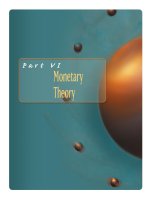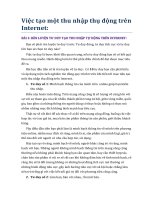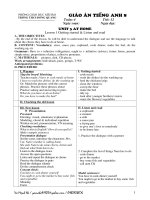Assessment 1 (10%) _ Financial Markets BAFI3182_ Online test (Week 4) (10%) (9.7510)
Bạn đang xem bản rút gọn của tài liệu. Xem và tải ngay bản đầy đủ của tài liệu tại đây (187.76 KB, 6 trang )
RMIT Classification: Trusted
COURSE TITLE: FINANCIAL MARKETS DURATION: 2 HOURS
MODULE CODE: BAFI3182(SGN) / BAFI3230(HN)
SEMESTER 1, 2022. ASSESSMENT 1, WEEK 4
INSTRUCTIONS TO STUDENTS
There is ONE Section and 5 Questions on this test.
Students are to answer all 5 questions.
You will have to use word processing software (Microsoft Word is the expectation) to answer your
chosen questions. You will have to type your answers out and upon completion, save your file. As
a precautionary note, please ensure that you continually save your document as you progress
through the assessment questions. Add your name and student ID at the start of the document and
clearly indicate the questions you have attempted.
Please note that this is a timed submission. The questions for Assessment 1 will be released during
your timetabled sessions for Week 4 and you will have 2 hours to complete the tasks.
Submission of your answer file is via Canvas. The Canvas link will close at the time indicated. No
uploads will be allowed after the stipulated time. Failure to upload your file within the indicated
time will constitute a non-attempt submission.
Notes and books can be utilised. Answers need to demonstrate your knowledge and understanding
of the questions and explanations need to be in your own words.
As, you will be submitting your files via Canvas, your answers will be checked for plagiarism.
Plagiarism is defined as the representation of the work of any other person from any source
whatsoever as your own.
This test consists of 3 pages
Page 1 of 6
RMIT Classification: Trusted
Subject Code BAFI3182
Subject Name Financial Markets and Institutions
Location and Campus
Assignment Title SGS Campus
Type of Assignment Online Test
Individual (10%)
Lecturer
Group Dr. Huy
Pages 09
6
Question 1
You are working as a Priority Relationship manager in Shinhan bank in Vietnam. Your client Ms.
Anna is a surplus unit who has decided to put her saving in Shinhan bank. Anna would like to save
an amount of money equal to the final digit number of your student number multiplying with
$1,000 for 12 months (for example: your student number is S3409112, the final digit number is 2
multiply 2 with $1,000 2*$1,000 = $2,000) ((in the event that your digit is 0, treat is as a 9)).
Note that the annual interest rate is equal to second digit of your student ID from the left, for
example, if your student ID number is S3409112, the interest rate is 4% p.a. (in the event that your
digit is 0, treat is as a 9). You should also note that the interest is compounded quarterly. How much
does Anna receive after the saving period?
(2 Marks)
SOLUTION
Based on my student ID number: S38xxxx9
Present Value (PV) = 9 x $1,000 = $9,000 (As my final digit number ID is 9)
Interest Rate (i) = 8% = 0.08 (As my second digit number ID from left is 8) (p.a.)
Time (t) = 12 months = 1 year
Since the interest rate is compounded quarterly => Compounding 4 times per year => m=4
Future Value (FV) =? ($)
i txm
FV = PV x (1+ m )
( ) FV = 9,000 x 1+ 0.08 1 x4 4
FV = 9,741.88944 ($)
Therefore, after the saving period of 12 months in Shinhan Bank (Vietnam), Ms. Anna will
receive $9,741.88944.
Question 2
Your firm is purchasing a new equipment system, which will last for five years. You can purchase
the system for an upfront cost of $150,000. Your firm can borrow to finance for this project in two
years. Calculate the effective annual interest rate for your firm given that the nominal annual
interest rate is equal to sixth digit of your student ID from the left, for example, if your student ID
Page 2 of 6
RMIT Classification: Trusted
number is S3409112, the interest rate is 1% p.a. (in the event that your digit is 0, treat is as a 9).
Note that the nominal interest rate is compounded monthly.
Briefly discuss what is the difference between an effective annual interest rate and nominal interest
rate quote?
(2 Marks)
SOLUTION
Based on my student ID number: s3xxxx6x
Nominal Annual Interest Rate (i) = 6% = 0.06 (As my sixth digit number ID from left is 6)
Nominal Interest Rate compounded monthly => Compounding 12 times per year => m=12
Effective Interest Rate (ie) =? (%)
ie = (1+ im )m – 1
= (1+ 0.06 12 ) – 1
12
= 0.0616778
= 6.16778%
The annual effective interest rate for my firm given that the nominal interest rate of 6% is
6.16778%
The concept of the interest rate takes two structures, which are nominal interest rate and effective
interest rate. A nominal interest rate works as per the simple interest and does not take into account
of interest being compounded more than once each year. On the other hand, the effective interest
rate does take the compounding period into account, hence, the effective interest rate is considered a
more exact measure of interest charges.
Question 3
What is the shape of the yield curve given the term structure in the graph of Vietnamese
Governmental bonds below? Utilising an adequate theoretical lens, discuss what expectations are
investors likely to have about future interest rates?
Page 3 of 6
RMIT Classification: Trusted
(2 Marks)
According to Market (Pure) Expectation theory, an upward sloping yield curve proposed that
investors expect to raise the short-term interest rate in the future over the period to confront
negative influences of higher risk in long-term investment, as well as to enlarge returns, regardless
of maturity. Thus, the short-term interest rate will surge which can be considered lead to the
increase of long-term interest rate averagely based on these theoretical expectations. However,
investing long-term tend to be riskier with lesser liquidity, consequently, issuers must offer higher
interest rates to make up higher returns for greater risk level associated with long-term investment-
called liquidity premium, attract more investors’ fund supply resources based on Expectations plus
liquidity premium theory. This contributed to the increment of yield rate in the future and the
upward-sloping shape of the Vietnam yield curve.
The Vietnamese yield bond curves present as a normal yield curve having the typical upward trend
with the remarkable interest rate increase in the long-term until Y2 to Y24, which means investors
can receive a larger amount of yield of holding bonds in a long-haul period. Also theoretically, the
normal yield curves (upward sloping curves) present that the long-term interest rate tends to be
higher than the shorter-term interest rate. However, investment for the long-term will be much
riskier, therefore investors would expect higher long-term interest rates in the future to obtain the
higher returns, purport to compensate for potentially higher risks of holding long-term bonds.
Simply take an observation at the "Vietnam (13 Mar 2022)" curve in the diagram, investors had
Page 4 of 6
RMIT Classification: Trusted
earned higher yields for their investment projects. Evidently, they can earn roughly 1.5% in Y2 and
then obtained double (3%) at Y24. Also, the 1M located higher than the 6M line indicated that the
bond yield obviously rises in the future. All have shown that longer-term bonds can be expected to
pay higher returns by investors to attract their reinvestment in Vietnamese Government Bond for
achieving optimal profits.
Question 4
The following statement is True or False: Assuming the pure expectations theory is correct, an
upward-sloping yield curve implies that interest rates are expected to decline in the future. Briefly
explain.
(2 Marks)
According to the Market (pure) expectation theory (as this theory is assumed is correct), an upward-
sloping yield curve implies that many investors expect the future short-term interest rates to rise to
evade the long-term risks and maximize their profits. A large number of investors believe holding
their assets in the long-haul periods is presented to be riskier, for example, changes in the interest
rate and exposure to possible defaults. Investing money for a long period means investors lock up
their invested money in other ways, so the opportunity cost of holding those long-term securities
has increased as their returns can be earned from other better investments. Furthermore, if investors
hold financial assets for a long duration with the fixed-rate interest, they can face their security
price fall, and lose many potential profits due to the influences of inflation on the time value of
money. Hence, based on the Pure Expectation theory, there will be a surge in short-term interest
rates in the future, which also increases the long-term interest rate because the long-term interest
rate is considered as the average of expected short-term interest rates.
Long-term investment offers more benefits for most borrowers to satisfy their financial
requirements but sustains higher interest rate risks than short-term ones for investors. So, to
persuade investors to buy long haul securities, financial issuers must propose higher interest rates to
recompense greater yields, aiming to reduce the high-risk potential in long-duration investments,
and incentivize investors to invest more, which provides a surplus of fund supply in long-haul
stages. Because of the previous mentions, the slope of the yield curve will move upward to
represent the higher yields associated with longer times to maturity. The longer the maturity spread,
the higher the interest rate level is expected by the financial market investors. It demonstrates that
an upward sloping yield curve suggests an increase in interest rate in the future. As a result, the
claim of “Assuming the pure expectations theory is correct, an upward-sloping yield curve implies
that interest rates are expected to decline in the future” is considered false.
Question 5
Page 5 of 6
RMIT Classification: Trusted
A company plans to purchase a zero-coupon bond with a face value equal to the fourth digit
number of your student number from the left multiplying with $1,000,000 (for example, if the
fourth digit of your student ID S3409112, the face price of the bond will be 9 * 1,000,000 =
$9,000,000 in the event that your digit is 0, treat is as a 9), a time to maturity of 1 year, and
annually compounded interest. The yield to maturity of this bond is equal to fourth digit of your
student ID from the left, (for example, if your student ID number is S3409112, the interest rate is
9% p.a., in the event that your digit is 0, treat is as a 9). Calculate the price that your company is
willing to pay for this bond.
(2 Marks)
SOLUTION
Based on my student ID number: s3xx7xxx
Face Value (FV) = 7 x $1,000,000 = $7,000,000 (As my fourth digit number ID from left is 7)
Time to maturity (t) = 1 year
Yield to maturity (y) = 7% =0.07 (As my fourth digit number ID from left is 7) (annually
compounded interest).
Price of bond (PV) =? ($)
PV = (1+ y )t FV
PV = 1 7,000,000
(1+ 0.07)
PV = 6,542,056.075 ($)
To sum up, the price of zero-coupon bond is $6,542,056.075
Page 6 of 6









